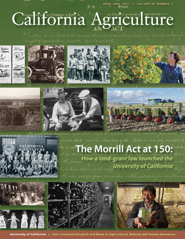All Issues

In 2012, UC celebrates the sesquicentennial of the federal Morrill Land-Grant College Act, which led to the creation of the University of California in Berkeley, the University Farm in Davis and the Citrus Experiment Station in Riverside. In the 21st century, Beth Grafton-Cardwell (top right) studies integrated pest management in citrus at UC Riverside; Abhaya Dandekar (bottom right) pursues a cure for Pierce’s disease of grapevines at UC Davis; and conservation tillage methods (center right) developed by UC researchers are being adopted on hundreds of thousands of acres in the Central Valley (see pages 54 and 55).
Click here for a PDF of the Morrill Act special reprint.
Click here for full information on historic cover photos.
Volume 66, Number 2





